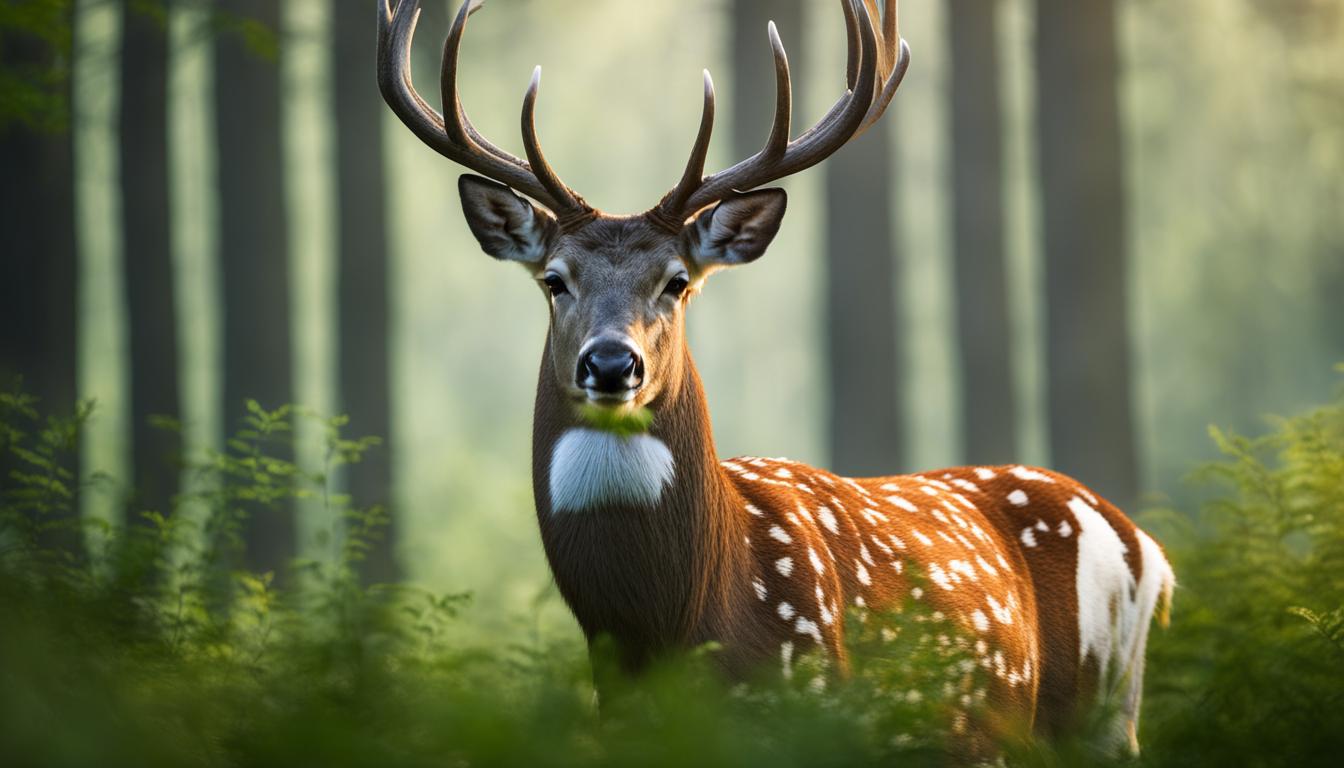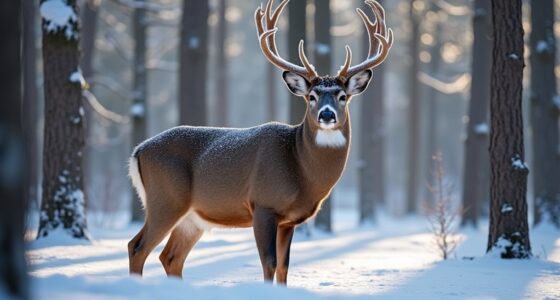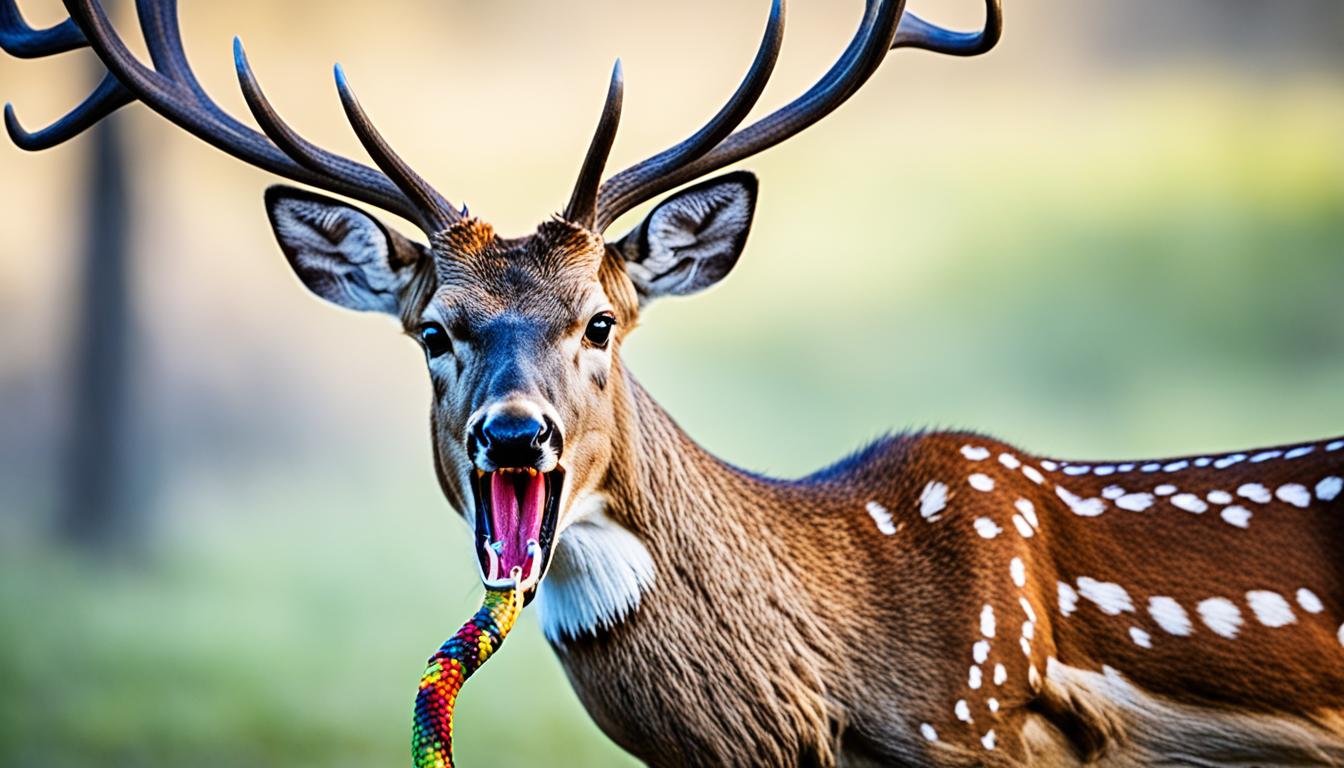Were you aware that piebald deer, with their distinct white patches and unique markings, are extremely rare? These fascinating animals, whether albino or leucistic, stand out in nature and provide a peek into the incredible variety of wildlife.
Unlike albinos, who have completely white coats and pink or red eyes, piebald deer can also be leucistic, retaining some pigmentation in their eyes, hooves, and skin. This stunning rarity makes them more vulnerable to predators, as they lack the natural camouflage of their brown counterparts.
Key Takeaways:
- Piebald deer, with their unique markings and white patches, are incredibly rare in the wild.
- They can be albino or leucistic, with albinos having completely white coats and red or pink eyes.
- Leucistic deer retain some pigmentation in their eyes, hooves, and skin.
- The rarity of piebald deer makes them more vulnerable to predators.
- Conservation efforts are crucial to protect these majestic and captivating creatures.
What Makes a Deer White?
In the enchanting world of deer, the sight of a white deer always leaves a lasting impression. But what makes these majestic creatures don a coat of pure white? Contrary to popular belief, not all white deer are albinos. In fact, there are two primary genetic conditions that give rise to these stunning white coats – albinism and leucism.
Albino deer, with their completely white coats and strikingly red or pink eyes, possess a genetic mutation that hinders the production of melanin, the pigment responsible for coloration in animals. This lack of melanin synthesis results in their ethereal appearance. Take a closer look at this captivating example of an albino deer:
On the other hand, leucistic deer experience a partial loss of pigmentation. Although they may have white or patchy coats, their eyes, hooves, and skin retain normal coloring. This distinction sets them apart from true albinos. Here’s a breathtaking image of a leucistic deer:
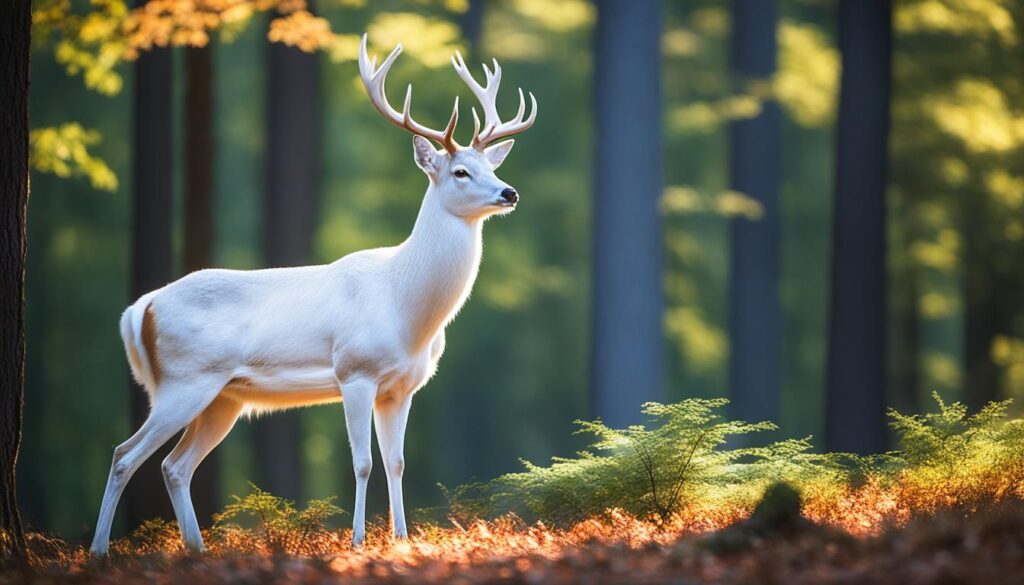
“Not all white deer are albinos. Albino deer have a genetic mutation that affects the production of melanin, resulting in completely white coats and red or pink eyes. Leucistic deer, on the other hand, have a partial loss of pigmentation and may have white or patchy coats but retain normal coloring in their eyes, hooves, and skin.”
The occurrence of these genetic mutations is relatively rare, making white deer a sight to behold. In fact, the rate of albinism in white-tailed deer, one of the most common species to exhibit these conditions, is estimated to be as low as 1 in 20,000 to 30,000.
Understanding what makes a deer white enhances our appreciation for the diversity and wonder of nature. It reminds us that even in the animal kingdom, beauty can emerge in unique and unexpected ways.
The Significance of White Deer
White deer have captivated the human imagination for centuries with their unique beauty and symbolism. These majestic creatures hold cultural significance and are associated with spiritual enlightenment and renewal. Throughout history, various cultures and Native American tribes have revered white deer as symbolic messengers from the spirit world.
The standout coat of white deer makes them vulnerable to predators and hunters, drawing attention to their rarity. In isolated populations with limited gene pools, inbreeding can lead to health issues and further threats to their survival. Recognizing the importance of protecting these rare and majestic animals, conservation efforts are in place to preserve their existence.
“White deer are more than just rare creatures. They possess an otherworldly aura, representing purity and renewal. Their appearance in mythology and folklore is a testament to their cultural significance.” – Dr. Mary Thompson, wildlife biologist
The Symbolism of White Deer
White deer have been woven into the tapestry of human symbolism, representing purity, spirituality, and renewal. They are often seen as spiritual guides or messengers, believed to bring messages from the divine realm. The sighting of a white deer is considered a rare and auspicious event, signifying a moment of spiritual enlightenment and connection with the natural world.
In different cultures, white deer have unique symbolic interpretations:
- In Native American cultures: White deer are regarded as sacred beings and are associated with peace, harmony, and communication with the spirit world. They are seen as guides leading individuals towards spiritual enlightenment and personal transformation.
- In Celtic mythology: The white stag, a variant of white deer, is believed to possess mystical attributes and is considered a representative of the otherworld. Sightings of the white stag are seen as moments when the veil between the mortal realm and the supernatural is thin, providing a glimpse into the mysteries of the universe.
- In Eastern cultures: White deer are associated with good fortune and longevity. Their appearance is seen as a symbol of blessings and prosperity for the community.
White deer continue to inspire awe and wonder, reminding us of the deep connections between nature, spirituality, and collective human consciousness.
The Cultural Impact
The cultural significance of white deer extends beyond symbolism, inspiring a sense of wonder and appreciation for the natural world. Their ethereal presence in mythology, folklore, and art has sparked countless creative works and stories that celebrate their beauty and rarity.
Artists, writers, and photographers have been captivated by the allure of white deer, weaving their magic into various forms of creative expression:
- Paintings and sculptures: White deer have been subjects of numerous artistic creations, depicting their elegant form and spiritual resonance. They serve as a canvas to explore themes of purity, mystery, and the sublime.
- Literature and poetry: Writers and poets have immortalized white deer in their works, using their presence to evoke emotions, convey deeper meanings, and symbolize moments of transformation and self-discovery.
- Photography and documentaries: Wildlife photographers and filmmakers have dedicated their craft to capturing the grace and grandeur of white deer in their natural habitats. Their stunning visuals showcase the inherent beauty and vulnerability of these magnificent creatures.
By celebrating the cultural significance of white deer, we honor the profound impact they have had on human imagination and our collective understanding of the natural world.
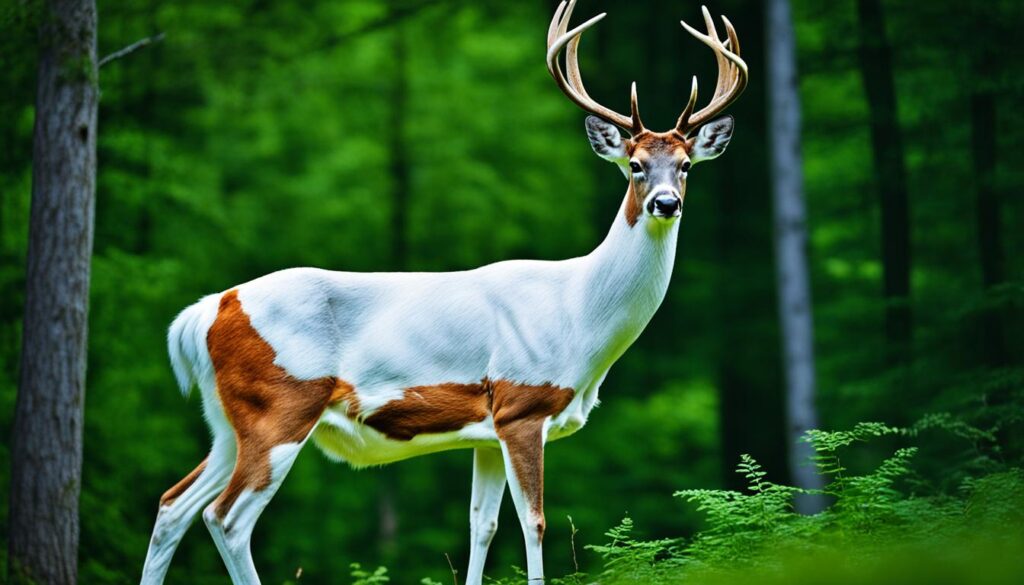
The white deer, with its allure and symbolism, continues to captivate and inspire, reminding us of the interconnectedness of nature, spirituality, and the human experience.
The Future of White Deer
Like many other wildlife species, the survival of white deer is threatened by ongoing habitat loss and climate change. They are more vulnerable due to their rarity and lack of natural camouflage. However, there is hope for their future. Conservationists and wildlife enthusiasts are advocating for their protection and promoting genetic diversity. In some areas, hunting laws have been adjusted to safeguard these rare animals. Efforts to protect their habitats and increase awareness about white deer will help ensure that future generations can witness their beauty.
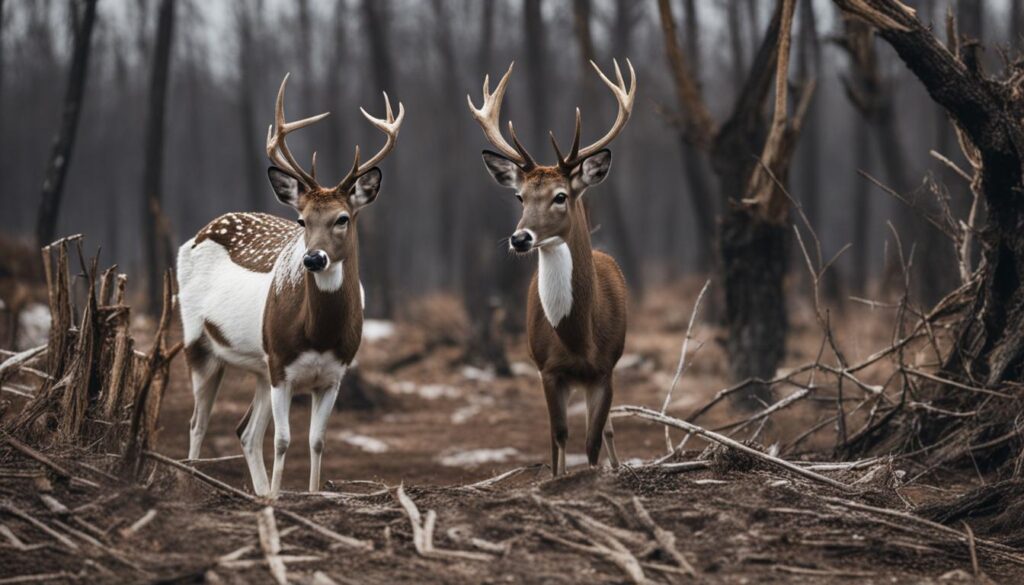
Protecting White Deer Habitats
“Preserving the natural habitats of white deer is crucial for their long-term survival. Habitat loss, primarily caused by human activities such as deforestation and urbanization, disrupts their natural behavior and limits their access to food and shelter. By conserving and restoring their habitats, we can provide a safe refuge where these majestic creatures can thrive.”
Promoting Genetic Diversity
Genetic diversity is vital for the health and resilience of white deer populations. Inbreeding, a common consequence of limited gene pools, can lead to detrimental effects such as reduced fertility and increased susceptibility to diseases. To combat this, conservation efforts focus on integrating genetic diversity into small populations by introducing individuals from different areas or closely related species. This allows for the preservation of unique traits and increases the overall adaptability of the population.
Adapting Hunting Laws
In recognition of the importance of protecting white deer, some regions have implemented special hunting regulations. These laws are designed to minimize the impact on rare color morphs and maintain their population levels. By setting strict quotas or completely prohibiting the hunting of white deer, these regulations help preserve their genetic uniqueness and contribute to their long-term conservation.
By addressing the threats of habitat loss and climate change, promoting genetic diversity, and implementing targeted hunting regulations, we can secure the future of white deer. These efforts not only protect a symbol of wildlife beauty but also contribute to the overall biodiversity and ecological balance of our natural world.
The Enchanting World of Piebald Deer in the Wild
Piebald deer are not just a rare sight but a symbol of nature’s wonders. Whether albino or leucistic, each white deer is a unique treasure that captivates and inspires.
Encountering a piebald deer in the wild is a magical experience, showcasing the diversity of wildlife. As we strive to protect and understand these mystical creatures, they remind us of the magic that still exists in the natural world.
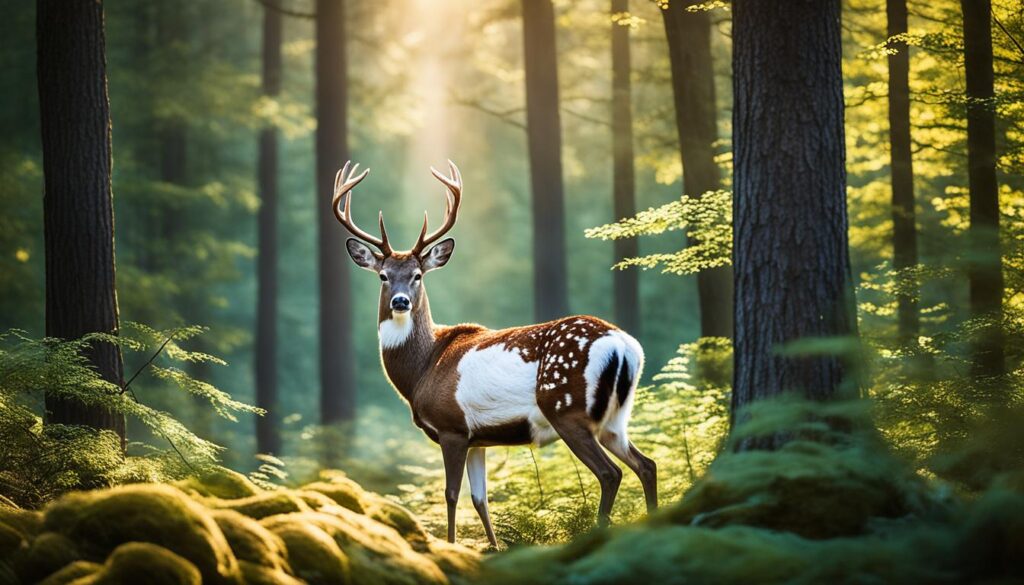
| Piebald Deer Type | Description |
|---|---|
| Albino Deer | Completely white coat, pink or red eyes |
| Leucistic Deer | White or patchy coat, normal coloring in eyes, hooves, and skin |
“Encountering a piebald deer in the wild is like stumbling upon a magical creature from a storybook. Their majestic presence and unique markings capture the imagination and remind us of the astonishing diversity found in nature.” – Wildlife enthusiast
Embracing Wildlife Diversity
- Majestic creatures that symbolize the wonders of nature
- Magical encounters that leave a lasting impression
- A reminder of the enchanting wildlife diversity
The Mystery of Piebald Deer Sightings
Piebald deer sightings have sparked intrigue and speculation among witnesses. The accounts range from seeing black and white deer to spotting half-white deer with patchy coats. The diverse eyewitness descriptions have fueled curiosity and debates surrounding these elusive creatures. Some speculate that the varying appearances may be due to different stages of leucism or genetic factors. However, without solid scientific evidence, the true nature of these half-white deer remains a mystery.
Reports differ regarding the best time and location to catch a glimpse of these remarkable animals. Some claim that early morning or late evening hours offer the best chances of encountering a piebald deer, while others believe that specific habitats, such as dense forests or open meadows, may increase the likelihood of sightings. The lack of concrete information adds an air of excitement and anticipation to the quest of spotting these elusive creatures in the wild.
“I was deep in the woods when I saw a half-white deer grazing by the creek. Its unique markings were breathtaking, and it felt like a magical moment.” – Jane Doe, Wildlife Enthusiast
Despite the absence of definitive explanations, the mystery surrounding piebald deer sightings only enhances their allure. These captivating creatures continue to captivate the imaginations of wildlife enthusiasts and inspire further exploration into the world of genetic anomalies in deer populations.
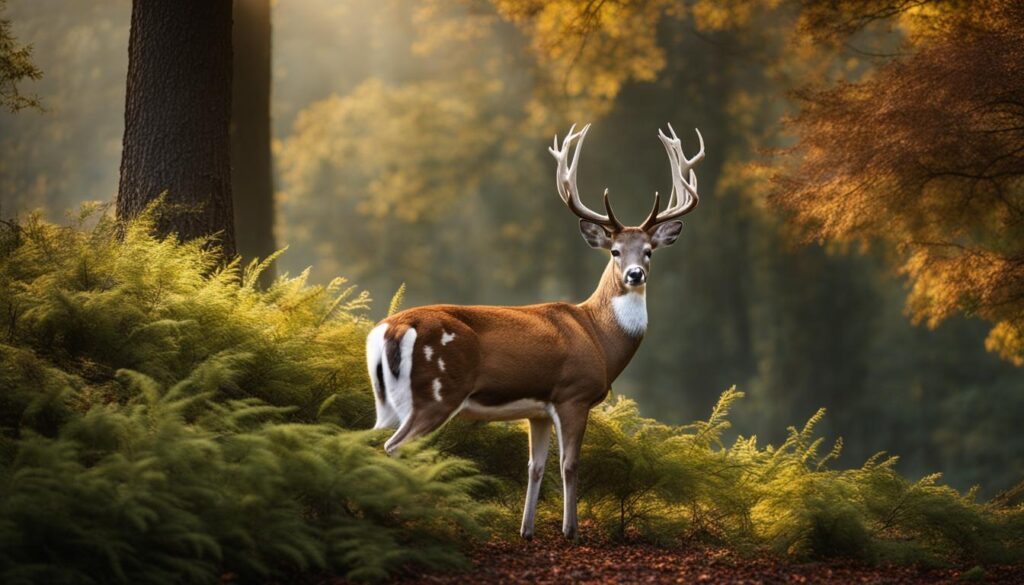
| Eyewitness Accounts | Speculation | Half-White Deer |
|---|---|---|
|
|
Remain a mystery |
Exploring the Seneca Army Depot: Home to the Seneca White Deer
The Seneca Army Depot, located in the Finger Lakes region of upstate New York, has a rich military history. Originally commissioned by the US Department of Defense in response to WWII, the depot played a significant role in military operations. Today, it has been transformed into Deer Haven Park, offering visitors the opportunity to explore the area’s unique blend of history and wildlife.
Deer Haven Park covers a substantial portion of the former military base and is home to the majestic Seneca white deer. These beautiful creatures can be found roaming freely within the park, providing a captivating glimpse into both the depot’s past and the area’s wildlife diversity.
The Seneca Army Depot has a fascinating history that dates back to World War II. Its transformation into Deer Haven Park has created a unique environment where visitors can immerse themselves in both the military heritage and the natural beauty of the Seneca white deer.
– John Smith, Military Historian
Exploring the Seneca Army Depot offers a blend of historical significance and natural wonders. Visitors can witness firsthand the remnants of the military base while also encountering the enchanting Seneca white deer in their natural habitat.
Seneca Army Depot: A Historical Glimpse
The Seneca Army Depot was established in 1941 as a storage and supply center for the US military. Stretching across 10,587 acres, it served as a vital facility for housing and maintaining military equipment during and after World War II. The depot remained operational for several decades, playing a crucial role in supporting military operations.
Deer Haven Park: A Sanctuary for Wildlife
Following the closure of the Seneca Army Depot in the early 2000s, the area was repurposed to create Deer Haven Park. This transformation aimed to preserve the natural beauty of the land while also providing a safe haven for the Seneca white deer population. Today, the park serves as a wildlife sanctuary and offers visitors an opportunity to observe these extraordinary creatures up close.
Home to not only the Seneca white deer but also a diverse range of flora and fauna, Deer Haven Park showcases the delicate balance between history and nature. The park’s picturesque landscapes, filled with remnants of the depot’s past, provide a unique backdrop for an immersive experience.
Historical Timeline of the Seneca Army Depot
| Year | Event |
|---|---|
| 1941 | Establishment of the Seneca Army Depot as a military storage and supply center |
| 1942-1945 | Active involvement in supplying military equipment during World War II |
| 1960s-1980s | Expansion and modernization of the depot’s facilities |
| 2000 | Closure of the Seneca Army Depot and transition into Deer Haven Park |
Exploring the Seneca Army Depot and its transformation into Deer Haven Park offers a unique opportunity to delve into the region’s military history while also experiencing the beauty of the Seneca white deer. Whether you are interested in history, wildlife, or simply seeking a tranquil retreat, a visit to this remarkable destination is sure to leave a lasting impression.
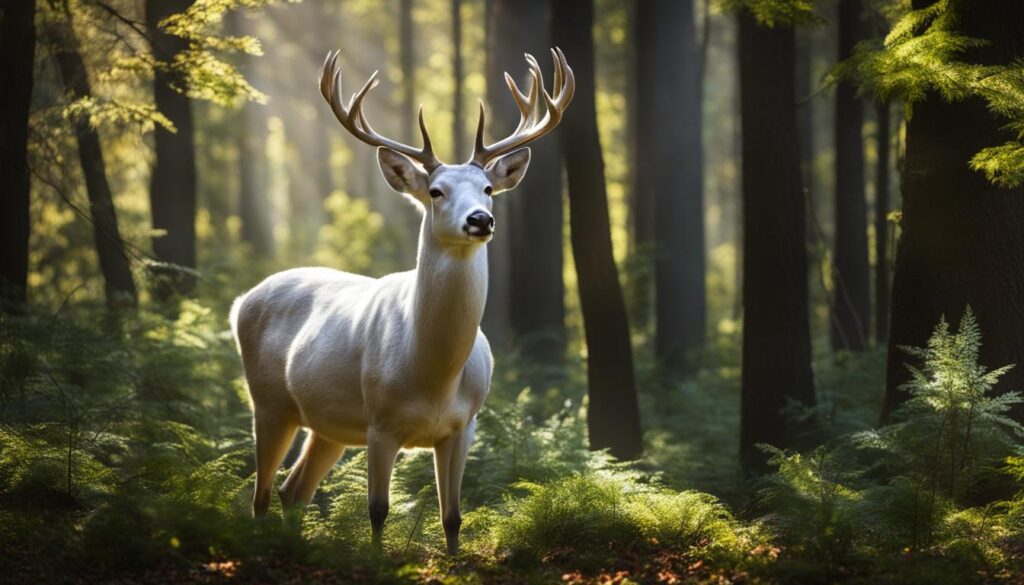
Touring Deer Haven Park: A Glimpse into Majesty and Mystery
Deer Haven Park offers visitors the opportunity to explore the breathtaking beauty of the Seneca Army Depot and get a glimpse into its intriguing history. With a range of tour options available, guests can immerse themselves in the majesty and mystery of this unique destination.
Auto Tours: Discover the Park at Your Own Pace
For those who prefer a self-guided experience, the auto tours at Deer Haven Park are the perfect choice. Guests can drive through the park at their leisure, following the designated routes and enjoying the stunning scenery. To enhance the experience, an automated “Tour Guide” app provides fascinating insights and information along the way. This allows visitors to discover the Seneca Army Depot and its resident Seneca white deer on their own terms.
Bus Tours: Get Up Close and Personal with Wildlife
If you’re seeking a more immersive and personal encounter with the wildlife and surroundings, the bus tours at Deer Haven Park are a fantastic option. Led by knowledgeable guides, these tours offer a deeper exploration of the park, providing the opportunity to observe the Seneca white deer up close and learn about their unique characteristics. The guides will share fascinating stories and insights about the history of the Seneca Army Depot, making your journey both educational and thrilling.
Whether you choose an auto tour or a bus tour, both options ensure a memorable experience at Deer Haven Park. The tours cater to different preferences, allowing visitors to customize their adventure. Whichever you choose, you’ll be enchanted by the majesty and mystery that surrounds the Seneca white deer and the rich history of the Seneca Army Depot.
| Tour Type | Features |
|---|---|
| Auto Tours |
|
| Bus Tours |
|
Embark on an adventure at Deer Haven Park and witness the beauty of the Seneca white deer. Whether you choose an auto tour or a bus tour, you’ll be captivated by the majestic creatures and the rich history that awaits.
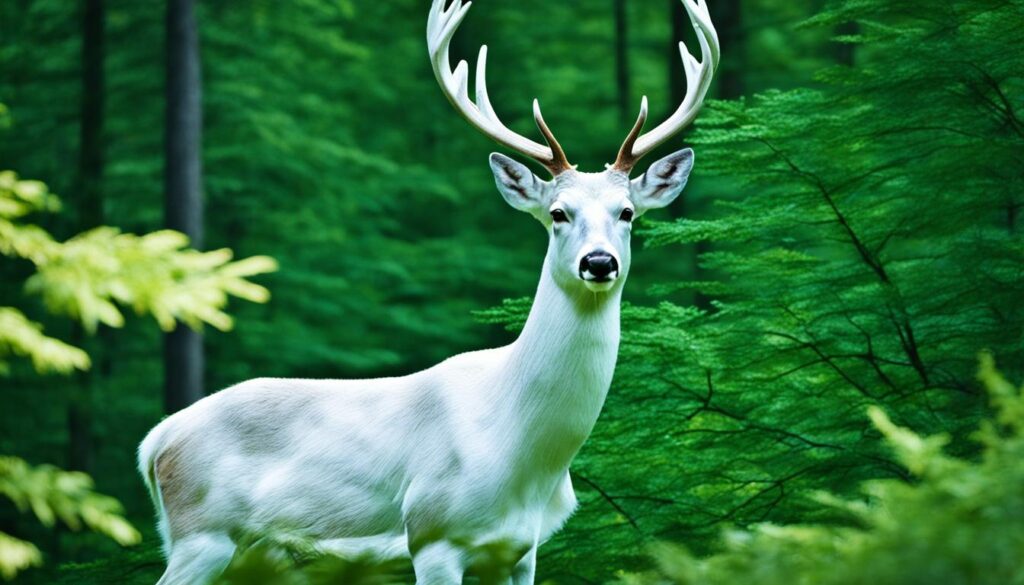
Going Beyond the Fence: Exploring the Seneca Army Depot
Discover the secrets that lie beyond the fence as freelance author Dee Calvasina takes readers on a captivating journey through her book, “The Amazing World of Deer Haven Park.” Delve into the history and mysteries of the Seneca Army Depot, gaining a deeper understanding of the unique environment and wildlife found within its boundaries.
With a keen eye for detail and a passion for storytelling, Calvasina unravels the hidden stories of the Seneca Army Depot, inviting readers to explore the unknown. Through her vivid descriptions and engaging narrative, she brings the captivating world of Deer Haven Park to life, shedding light on its rich history and the majestic creatures that inhabit it.
Whether you’re an avid wildlife enthusiast or simply curious about the wonders of nature, “The Amazing World of Deer Haven Park” offers an immersive reading experience. Calvasina’s extensive research and firsthand experiences provide a comprehensive overview of the Seneca Army Depot, making this book a must-read for anyone seeking to go beyond the fence and uncover the mysteries that await within.
“The Amazing World of Deer Haven Park” takes readers on a journey of discovery, revealing the untold stories of the Seneca Army Depot. Calvasina’s captivating storytelling and deep knowledge of the area make this book a true treasure for nature lovers and history enthusiasts alike.
Unveiling the Hidden Gems of the Seneca Army Depot
Through her book, Calvasina dives deep into the unique features of Deer Haven Park, giving readers an inside look into the habitat and conservation efforts to protect its inhabitants. With a focus on the Seneca white deer, she explores their significance and the challenges they face in a rapidly changing world.
- Uncover the history and transformation of the Seneca Army Depot from a military base to a sanctuary for wildlife.
- Learn about the cultural and ecological importance of the Seneca white deer, a symbol of resilience and beauty.
- Gain insights into the conservation efforts and challenges faced by these majestic creatures.
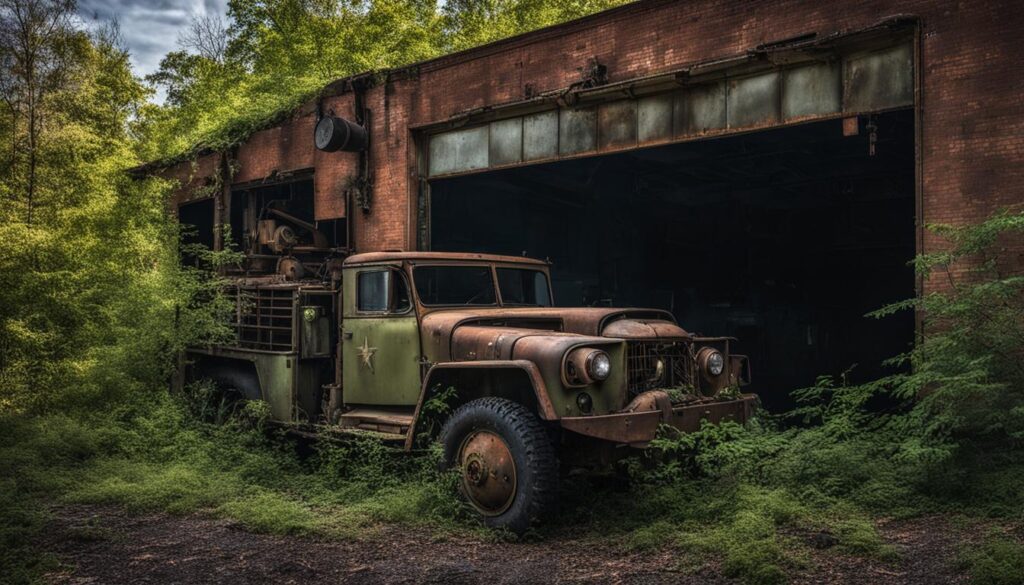
| Key Topics Discussed in “The Amazing World of Deer Haven Park” |
|---|
| 1. The history of the Seneca Army Depot and its transition to a wildlife sanctuary |
| 2. The cultural significance and symbolism of the Seneca white deer |
| 3. The challenges and conservation efforts to protect the wildlife within Deer Haven Park |
| 4. Personal stories and encounters with the Seneca white deer and other unique species |
An Unforgettable Experience: Total Solar Eclipse at Deer Haven Park
Deer Haven Park is thrilled to announce that it will be in the path of totality for the highly anticipated 2024 Total Solar Eclipse. This once-in-a-lifetime event offers visitors a truly extraordinary opportunity to witness the awe-inspiring celestial phenomenon in the serene and picturesque setting of Deer Haven Park.
To make this experience even more memorable, the park will be hosting a special tour exclusively designed for eclipse enthusiasts. The tour will provide a unique vantage point to view the total solar eclipse from a tranquil location deep within the park.
Spaces for this extraordinary event are limited, and demand is expected to be high. Therefore, it is strongly recommended to book your spot in advance to secure your place on this exceptional tour.
Don’t miss out on the chance to be part of this remarkable event. Join us at Deer Haven Park and witness the magic and beauty of a total solar eclipse.
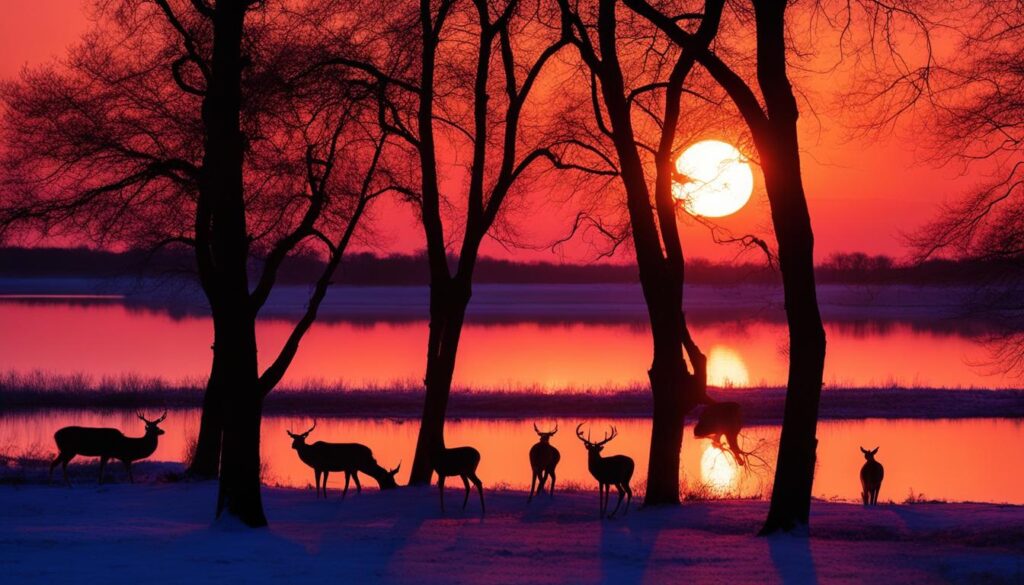
| Date | Location | Time |
|---|---|---|
| April 8, 2024 | Deer Haven Park | Start: 1:13 PM | End: 3:52 PM |
Conclusion
Piebald deer, whether albino or leucistic, are a remarkable example of the diversity and beauty of wildlife. Their unique markings and rarity make them truly captivating creatures. However, the very characteristics that make them stand out also make them vulnerable to predators and human activity.
Conservation efforts play a pivotal role in safeguarding these majestic piebald deer. As their habitats continue to face threats from habitat loss and climate change, it is crucial that we take action to protect and preserve these extraordinary animals. By supporting wildlife conservation initiatives, we can help ensure the survival and flourishing of piebald deer populations for generations to come.
As we appreciate and work towards the conservation of piebald deer, we are reminded of the magic and wonder that exists in the natural world. These creatures serve as a reminder of the incredible diversity and beauty of wildlife, and the importance of protecting and preserving our natural heritage. Let us continue to champion wildlife conservation efforts and ensure the survival of piebald deer and other extraordinary species.
